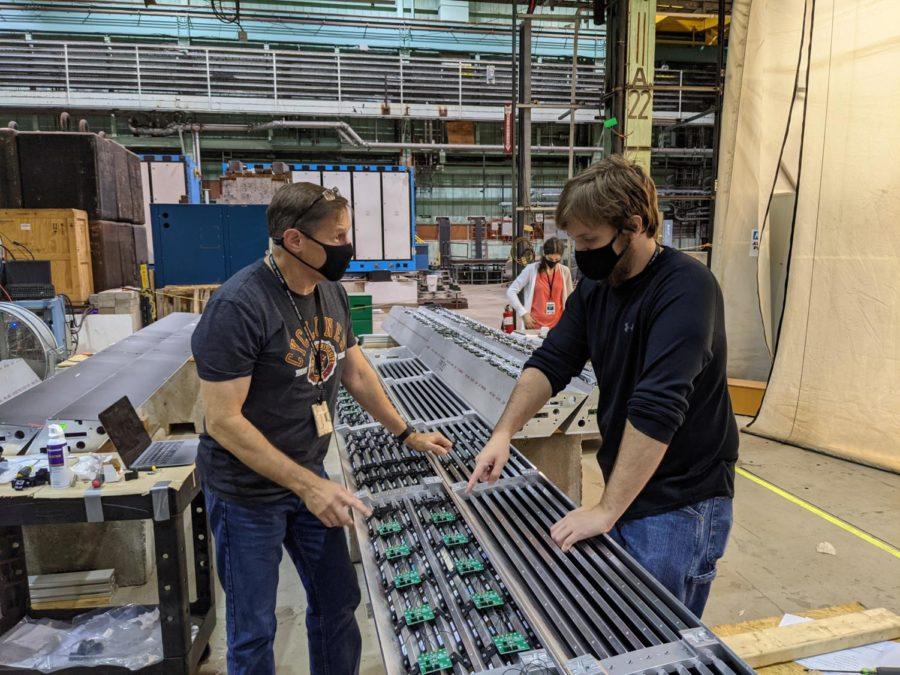Iowa State researchers to contribute to sPHENIX experiment
Image shows John Lajoie (left), Grad student Noah Applegate (right) and Postdoc Veronica Canoa Roman (back) working on the iHCAL sectors at BNL.
November 11, 2021
Iowa State is making contributions to the sPHENIX experiment at Brookhaven National Laboratory’s Relativistic Heavy Ion Collider. The experiment will work to understand the nature of the nearly perfect fluid that filled the universe’s earliest moments, quark-gluon plasma.
The Relativistic Heavy Ion Collider (RHIC) is one of only two machines in the world that can collide ions as heavy as gold; the other is the Large Hadron Collider in Geneva, Switzerland. These ions collide at very near the speed of light, creating a super dense, superheated soup of quarks and gluons. Extremely precise sensors allowed physicists to observe QGP as the particles that make up protons and neutrons cease to be confined to the individual particles.
At RHIC the collision energy is at the “sweet spot” for studying the phase transition to a QQP. Professor of Physics and Astronomy at Iowa State and a contributor to sPHENIX, John Lajoie, explained the understandings behind this unfamiliar state of matter.
“It’s very analogous to melting ice, it undergoes a phase transition,” said Lajoie. “So think about ice melting into water. The nuclei undergo a phase transition where the quarks and the gluons that hold them together are no longer required to stay inside the individual protons and neutrons, but they can now range over a much larger distance.”
This plasma of quarks and gluons was observed to possess astounding properties. Initially assumed to behave like a gas, physicists were surprised to learn that plasma behaves more like a fluid. Not only did the plasma behave like a fluid, but the shear viscosity of the plasma was as low as our modern understanding of physics allows. This means that the plasma flows extremely well, without turbulence or losing energy.
Through this nearly perfect flow of energy, physicists could even observe the dissipation of density fluctuations within the nuclei from before the collision. Lajoie explained just how that is so significant.
“And that was fantastically surprising, right that that information would survive through this violent collision and into the final state,” said Lajoie. “And it turns out, I mean, the way they flow their nature has a lower limit to how perfectly a fluid can flow and the quark gluon plasma is right at that lower limit,”
The strongly coupled nature of QGP demanded further studying; thus the sPHENIX detector began construction at the Relativistic Heavy Ion Collider at Brookhaven National Laboratory. The sPHENIX detector will be capable of much more in-depth observations and will allow physicists to ask more specific questions about the nature of QGP.
Iowa State researchers and faculty are making contributions to sPHENIX in two main areas. The first area is the manufacturing of parts to be used in the experiment. The experiment is roughly the size of a small house, thus it has to be built in small chunks to be sent to Brookhaven and assembled. The experiment is set to be completed in 2023, when it will begin colliding protons from gold ions, stirring up little cosmic bangs for researchers to observe.
Iowa State researchers will also contribute to sPHENIX through data analysis, drawing understandings of matter from the raw data and numbers. Lajoie explained how sPHENIX stands to benefit people and the ultimate goals of the project.
“So if you literally asked me like, like my relatives do, right, you know, ‘what good is it?’ I don’t, I really don’t know, right. But you’re not going to ever find out unless you start,” said Lajoie.
He continued to offer an anecdote to explain the process of understanding the world around us. Lajoie pointed out that in the 19th century, James Clark Maxwell developed a theory that pulled together all of our understandings of electricity and magnetism and other forces that at the time defied our understanding of the universe. Lajoie pointed out that it wasn’t until nearly a century later that real applications of the understandings brought about by Maxwell began to revolutionize our civilization
Like Maxwell’s theories, sPHENIX by itself is unlikely to immediately bring about a revolution in our lives. However, there is tremendous value in laying the foundations for a deeper understanding of matter and the forces that govern its interactions. No one knows where this understanding could take us in another hundred years.
















